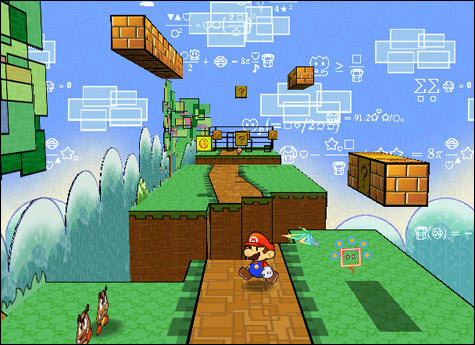
FLAT SCREEN: As the game keeps forcing you to re-evaluate what you’re looking at, you can almost feel your brain rewiring.
|
There’s a logical contradiction in trying to create three-dimensional environments on a two-dimensional display. You can have all the bump-mapping and particle effects you want, but playing a game on a television set is never going to look real. Super Paper Mario understands this natural limitation and embraces it. Like no game in recent memory, the newest Mario keeps playing tricks on your eyes, knocking down spatial expectations as quickly as it sets them up. Some games try to be like movies, but Super Paper Mario could not exist in any other medium.
It all comes down to what seems at first like a gimmick. As in previous Paper Mario games, all the characters appear to have been printed on paper. When Mario turns from one direction to the other, he almost vanishes. The look of the game is bright and cartoon-like; characters are outlined in bold, black strokes and move across minimalist backdrops. The simplicity of the images shows artistic verve, but it kicks into another gear when at the beginning Mario is granted the ability to “flip” into the third dimension. What might have seemed a standard side-scrolling platformer becomes much more as the display rotates to reveal depth of field. In the two-dimensional view, you may see a pipe locked in by blocks; in three-dimensional view, the pipe is revealed to be nowhere near the blocks along the Z-axis. Even when you do get the hang of flipping dimensions, the game never stops showing you something new. It’ll plunge you into the “Whoa Zone,” in which you may walk through a door on the ground and emerge upside-down somewhere else. As you’re continually forced to re-evaluate what you’re looking at, you can almost feel your brain rewiring.
Although the visuals are groundbreaking, the interface is about as traditional as it gets. Super Paper Mario barely takes advantage of the Wii remote; when it does, the remote feels superfluous. You can point it at the screen to search for hidden doors, and shaking it helps you earn extra points during attacks. That’s about it. Otherwise, the controls have a simplicity not seen in years: there’s a jump button and an action button, and you control Mario with a digital directional pad. It’s barely different from the original Super Mario Bros.
The gameplay, however, is a bit slower and less involving than it should be. That’s due in part to the RPG elements; as the game progresses, you acquire items and additional playable characters, but using any of them requires you to navigate a clunky, text-driven menu. Lacking a quick-swapping button function, you spend much of your time setting up your next move, even if it’s something as simple as using the Princess to float across a wide gap. The level design, clever as it is, also contributes to the sometimes lethargic feel. There’s a lot of backtracking, and it usually involving locating keys. Combine this with easy, repetitive boss battles and you have a game that never quite breaks through to greatness.
Nevertheless, Super Paper Mario is worth playing for its boundless creativity and enthusiasm. It’s funny, too, with foes like an Internet troll named Francis and a brainwashed Luigi. (The latter calls himself “Mr. L, a/k/a the Green Thunder” and attacks you in a machine he calls the “Brobot.”) It can be easy to forget, after playing the umpteenth World War II shooter, that video games have the power to show us things we’ve never seen before. Mario is here to remind us.